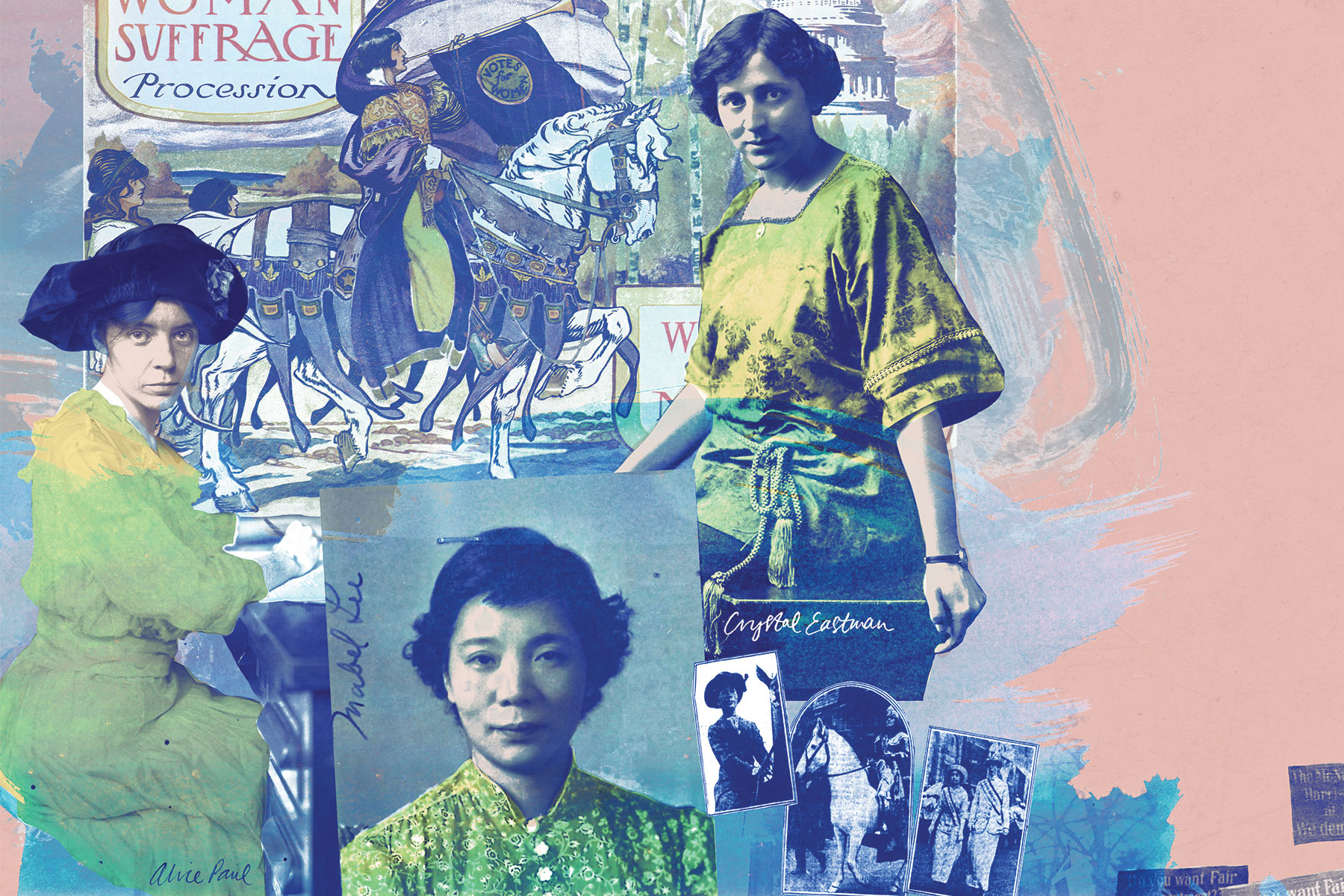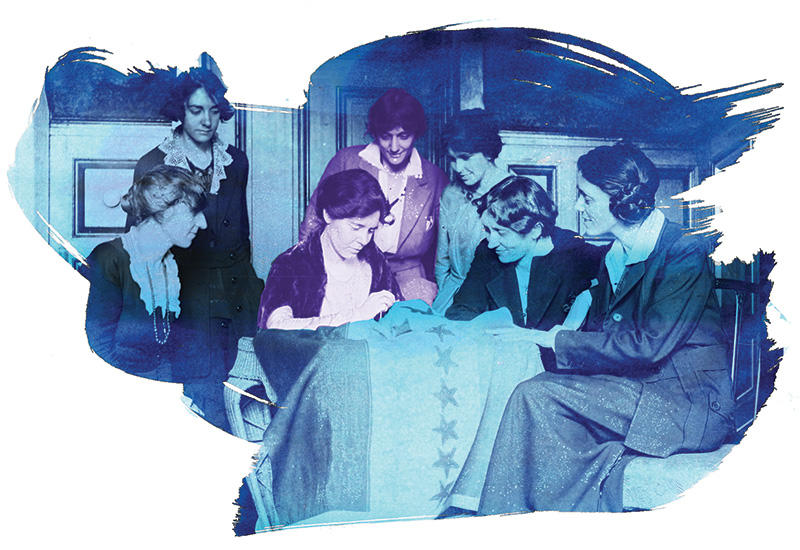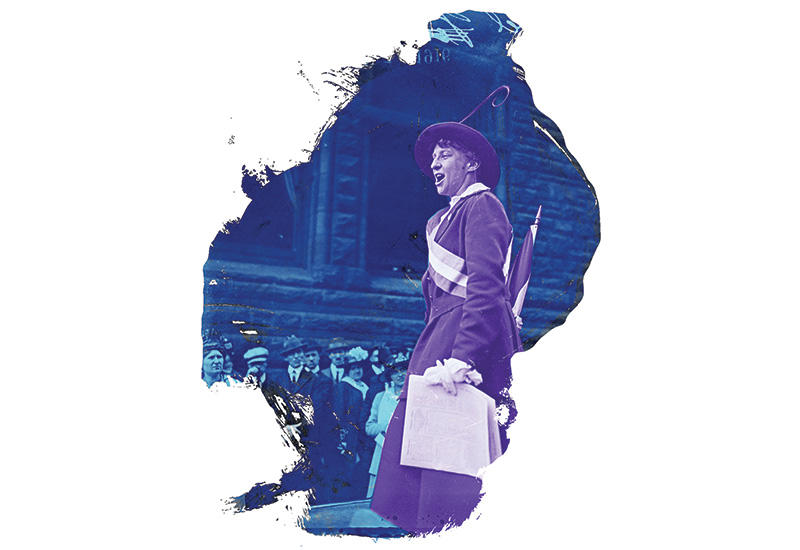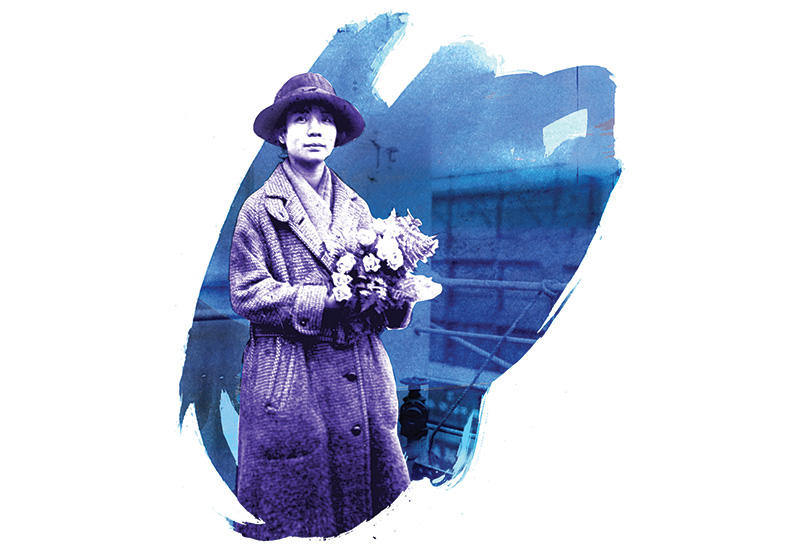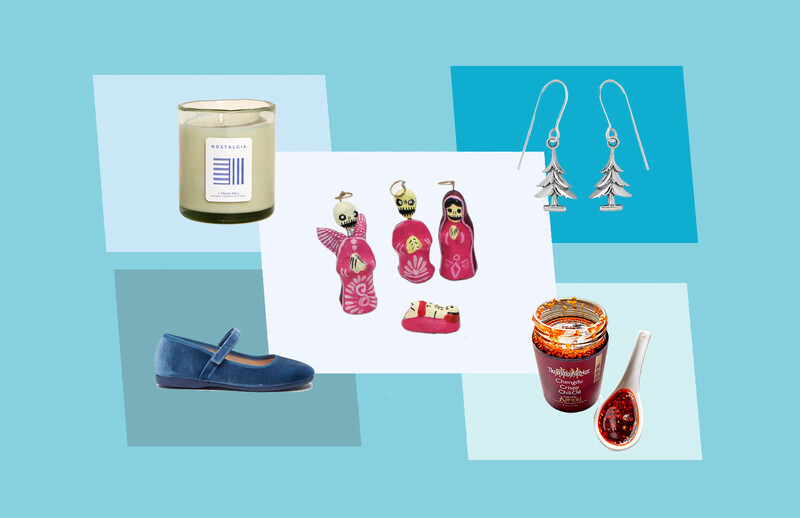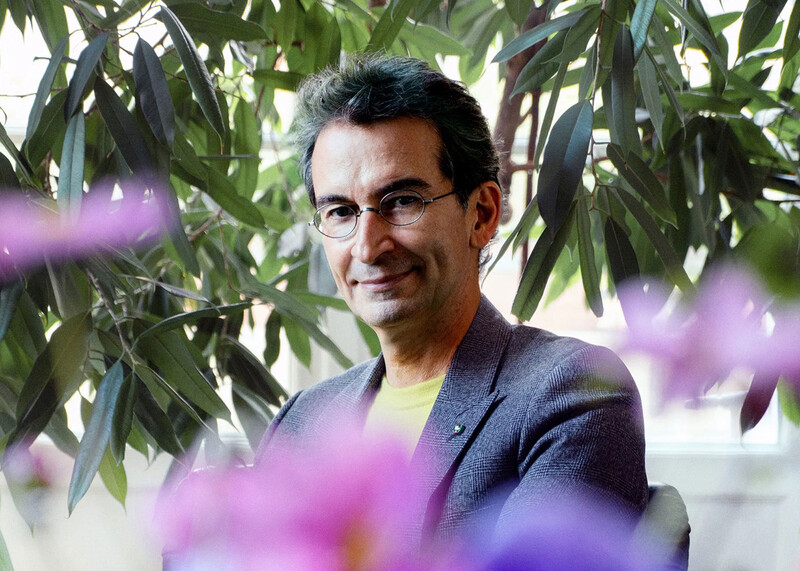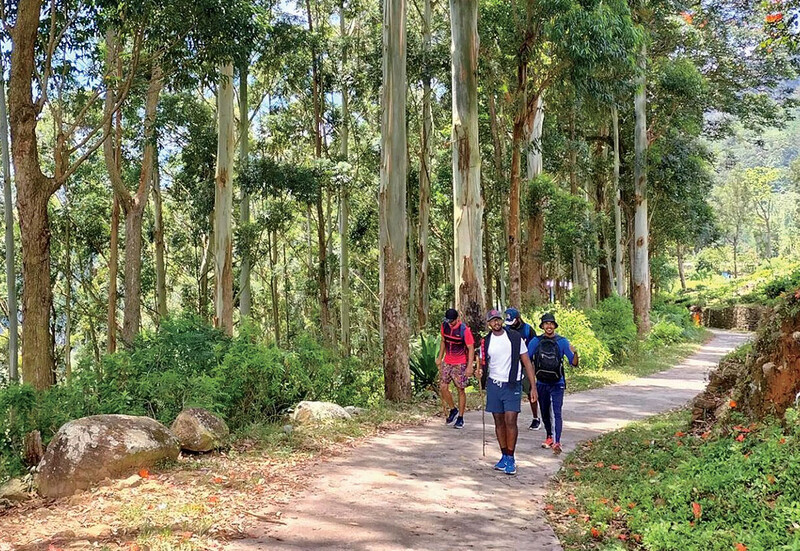The parade started at 5:00 p.m. at Washington Square Park. As the sun wheeled to the west, rods of golden light brightened the white dresses of the suffragist leaders, fired the yellows and purples and greens of their banners and flags, and shimmered on the flanks of the fifty horses poised under the park’s grand arch. It was May 4, 1912, and the women riders were set to lead a procession up Fifth Avenue to Carnegie Hall. With ten thousand marchers and thousands of spectators jamming the sidewalks of the three-mile route, New York was witnessing a spectacle like none other in its history.
For more than sixty years, suffragists had been demanding the enfranchisement of women in America, and progress had been painfully slow: by the spring of 1912, just five states, all in the West, had given women the right to vote. But two events in 1911 helped make this suffrage parade the biggest one yet: a fire in the Triangle Shirtwaist sweatshop on Washington Place that had trapped and killed 146 people — most of them young women — and the state legislature’s failure to pass women’s suffrage in New York.
Sixteen-year-old Mabel Lee 1917BC, 1918TC, 1921GSAS, then a student at Erasmus Hall High School in Brooklyn, touched the brim of her broadcloth hat and shifted in her saddle. Riding in the vanguard, she turned to survey the flood of marchers in her wake. There were nurses, teachers, writers, dressmakers, cooks, and actresses. Men gazed silently from the windows of their social clubs. Some on the street jeered, “Who’s minding the babies?”
Male marchers, among them Columbia philosophy professor John Dewey, Columbia economics professor Vladimir Simkhovitch (who years later would become Lee’s dissertation adviser), and the writer and activist Max Eastman (who studied philosophy at Columbia with Dewey), braved shouts of “Henpecked!” from the mob. Women and children held signs: MORE BALLOTS, LESS BULLETS and WE WISH MA COULD VOTE.
Born in 1896, Mabel Ping-Hua Lee had spent her early years in China attending a missionary school before she and her mother came to New York to join her father. The family lived at 53 Bayard Street in the heart of Chinatown, where her father, Lee To, a Baptist minister, was pastor of the Morning Star Mission on Doyers Street and a prominent neighborhood figure. Since he was a missionary, he and his wife and daughter were exempt from the Chinese Exclusion Act of 1882, which barred Chinese laborers from immigrating to the United States. Still, the Lee family, like other Chinese people permitted to enter the US, could not, by law, become citizens.
Without citizenship, Lee, even had she been old enough, would not have been able to vote. Her parents could not vote. But in China, where the 1911 revolution had ended the Qing dynasty and ushered in a new republic, women’s rights were ascendant. Lee was loyal to two countries and called for women’s empowerment in both. At sixteen, she rode toward a future of boundless promise.
While the suffragists marched in New York, Crystal Eastman 1904GSAS, Max Eastman’s sister, was in Wisconsin, organizing for the National American Woman Suffrage Association (NAWSA), the country’s largest suffrage organization. Formed in 1890 by Elizabeth Cady Stanton, Susan B. Anthony, and Lucy Stone through the merger of two rival organizations, NAWSA pushed for a federal constitutional amendment. That amendment, which read, “The right of citizens of the United States to vote shall not be denied or abridged by the United States or by any State on account of sex,” had first been introduced in 1878. But Congress had rejected it repeatedly, and so by the early twentieth century, NAWSA, under a new generation of leaders, abandoned the federal strategy and took the fight to the individual states.
In Wisconsin, where Eastman lived with her Milwaukee-born husband, Wallace “Bennie” Benedict, she faced bitter opposition. Aside from the usual arguments — that suffrage would destroy the order of the family, or that women were either too delicate or too virtuous for the muck and mire of politics — the state’s powerful brewing industry was dead set against granting the temperance-minded sex a say-so at the ballot box. But Eastman was formidable: standing six feet tall, she was a lawyer, activist, and social reformer known for her landmark 1907–08 study of workplace injuries in Pittsburgh, which led to the nation’s first workers’ compensation laws. To many vested interests, she was terrifying.
Like Mabel Lee, Eastman was the daughter of clergy: her father, Samuel, was a Congregational minister, and in 1892 her mother, Annis, had been named co-pastor of the abolitionist Thomas Beecher’s church in Elmira, New York, making her one of America’s first female Congregational ministers.
“Annis Eastman was an enormous influence on her daughter,” says Amy Aronson ’96GSAS, author of Crystal Eastman: A Revolutionary Life. “Crystal blurred her own story and achievements into those of her mother and always tried to live up to the ideal of her mother in practice and in principle.” She was also close with Max, her younger brother and intellectual ally (in 1918 they started the socialist magazine the Liberator together). It was a feminist, progressive family, with Annis at its spiritual head, and growing up in a collective on Seneca Lake, New York, Eastman had learned an unconventional style of homemaking. “Crystal argued for the sharing of housework and childcare her entire life,” says Aronson. “While her peers focused on wage work outside the home as the sine qua non of female independence, Crystal insisted that a career also had to be balanced by real feminist changes inside the household, inside the marriage, and inside the family for women to be truly free.”
At Columbia, Eastman had earned her MA in the new field of sociology, studying with the economic theorist John Bates Clark, cofounder of the American Economic Association, and Franklin Henry Giddings, who introduced statistical analysis to American sociology. “Both professors were important in shaping her — Clark in forming her socialistic critique of society and Giddings in the statistical methodology that she applied to the Pittsburgh Survey,” says Aronson.
Having gotten her master’s, Eastman entered the NYU School of Law, but despite finishing second in her class in 1907, she could not get a job as a lawyer. In 1911 she moved with Bennie to Wisconsin, which was the only state east of the Mississippi with a pending suffrage referendum. There she worked for the Political Equality League, with NAWSA paying half her salary. The stakes were high, and Eastman worked hard to muster votes. She cultivated ties with European feminists and even got Emmeline Pankhurst, matriarch of the British “suffragettes,” as they called themselves, to travel to a state that “had a hard time getting headliners,” Aronson says. But unexpected resistance from Scandinavian-American voters (“I sometimes think the last thing a man becomes progressive about is the activities of his own wife,” Eastman later quipped) and dirty tricks from the beer interests sank the effort.
Some NAWSA members had lost patience with the state-by-state grind. In New York, Alice Paul 1908SW and Lucy Burns (who had also studied at Columbia for a time) petitioned NAWSA to let them revive the campaign for a federal amendment. The two young Americans had met in a London police station in 1909 while studying abroad and apprenticing in Pankhurst’s Women’s Social and Political Union. Pankhurst and her daughters taught Paul and Burns the art of confrontational protest and civil disobedience: donning disguises to enter buildings, picketing Parliament and shouting down MPs, going on hunger strikes. Paul, who was jailed in London and Glasgow for nonviolent acts and was force-fed, gained an appreciation for the efficacy of spectacle and direct action.
NAWSA, which was staunchly non-partisan, reluctantly agreed to allow Paul and Burns to lobby for a federal amendment as a semiautonomous group called the Congressional Union for Woman Suffrage, on the condition that they raise their own money.
Paul, the daughter of New Jersey Quakers, saw partisan politics as the logical means by which the party in power could be held to account. With Democrat Woodrow Wilson prevailing in the 1912 presidential election, she decided to organize a suffrage parade in Washington the day before Wilson’s inauguration. Burns suggested they bring in her old Vassar classmate Crystal Eastman, the brilliant organizer and lawyer, to help. Eastman was game. The plan was to hold a huge procession down Pennsylvania Avenue.
The parade could not have gone worse — or better. There were five thousand marchers, twenty-four floats, and nine women’s marching bands. The avenue teemed with men in bowler hats, many of them in town for the inauguration, and a number of them drunk. They broke through barricades and swarmed into the path of the parade. They spat at the marchers, heckled them, kicked them. With the police failing to control the crowd — and in some cases joining in the abuse — the parade was squeezed into a single-file fragmented line amid the sea of hats. The fiasco became a cause célèbre in the press and led to a hearing on police misconduct on Capitol Hill.
The attention was more than Paul could have hoped for, and donations rose. Even anti-suffragists, disgusted by the treatment of the women, gave money to the cause.
Crystal Eastman was not in Washington that day. She and Bennie had gone to Budapest for an international suffrage conference — and for what Eastman conceived as a second honeymoon in Europe, in hopes of saving her marriage.
When Mabel Lee arrived at Barnard in 1913, she was one of four Chinese students at the college. She joined the Chinese Students’ Alliance, a national organization, mostly male, in which Columbia had the largest enrollment. “That was a point of pride at Columbia,” says Cathleen D. Cahill, author of Recasting the Vote: How Women of Color Transformed the Suffrage Movement. Cahill reports that Lee studied history and philosophy, was active in the debate club, gave talks at the YWCA, and contributed to the alliance’s journal, the Chinese Students’ Monthly.
In the spring of 1914, Lee, at seventeen, published “The Meaning of Woman Suffrage,” a precocious essay that emphasized equality in education and the economic liberation of women. Defining democracy as “equality of opportunity,” Lee aimed to show that true feminism “is nothing more than the extension of democracy or social justice and equality of opportunities to women.”
The Reverend Bayer Lee ’90TC (no relation) is the pastor of the First Chinese Baptist Church in Chinatown — the church that Mabel Lee established in memory of her father. A congenial scholar of wide interests, Rev. Lee came to the church in 2004 and has been trying ever since to piece together the story of this intensely private woman who never fit the radical mold of Eastman or Paul. He notes that after the 1911 Chinese Revolution, she supported Yuan Shikai, a military leader of the overthrown Qing dynasty. “He essentially was advocating a restoration of the emperor,” Rev. Lee says, “and became vilified by many who wanted China to enter into democracy and support Sun Yat-sen,” the revolutionary hero of American progressives.
But if Mabel Lee felt that China needed a strongman to defend against the menace of foreign aggression, she was steadfast in her feminism, writing in her 1915 essay “China’s Submerged Half” that China’s future depended on “rendering tardy justice to its womankind,” and that without the equality of women, “no nation can ever make real and lasting progress in civilization.”
In her seminal historical analysis The Ideas of the Woman Suffrage Movement, 1890–1920, Aileen S. Kraditor ’62GSAS identifies two chief arguments for suffrage: justice and expediency. The former, as espoused by Stanton and Anthony in the nineteenth century, appealed to the idea of natural rights and Jefferson’s principle of the “consent of the governed.” The latter evolved in an increasingly industrialized, urbanized society in which the need to protect workers and children and the food supply cried out for the electoral participation of women.
Crystal Eastman was an avatar of the anger many women felt at being excluded from basic decisions that affected every aspect of their lives. When “the dead bodies of girls are found piled up against locked doors leading to the exits,” she wrote two weeks after the Triangle fire, “when we know that locking such doors is a prevailing custom in such factories, and one that has continued in New York City since those 146 lives were lost … who wants to hear about a great relief fund? What we want is to start a revolution.”
When Eastman returned from Europe in the spring of 1913 to rejoin Paul and Burns, the Congressional Union for Woman Suffrage was strapped for cash. Eastman set up a meeting with Alva Belmont, a multimillionaire NAWSA supporter, and persuaded her to switch her allegiances. This was a game-changer: with Belmont onboard as a financier, Eastman in 1914 could travel out west to the suffrage states, rallying support for the federal amendment among enfranchised women — a battle-axe to wave at Congress. Says Aronson, “Crystal testified before the House Judiciary Committee and basically said, ‘We have four million women voters, and they are with us, and you don’t want to face them when you’re up for reelection. Why turn us into enemies?’”
Eastman’s efforts to save her marriage were less successful: she and Bennie divorced in 1916. By then, with war consuming Europe, she had founded two antiwar organizations: the Woman’s Peace Party, which later became the Women’s International League for Peace and Freedom, and the American Union Against Militarism, whose civil-liberties bureau would become the ACLU. And in 1916, she and Paul broke entirely from NAWSA and formed the National Woman’s Party, whose militant spirit, inspired by the Pankhursts, was decidedly at variance with the tearoom rectitude of NAWSA.
The English suffragettes not only influenced the radical American suffragists; they also joined in their actions. In 1908, Bettina Borrmann Wells 1915GSAS, a Bavarian-born Englishwoman, came to New York to “stir people up,” as she told the press. “Years of peaceful methods had accomplished nothing,” she said, rationalizing the most extreme suffragette tactics — arson, vandalism — as the time-honored methods of male justice seekers everywhere. On soapboxes from Brooklyn to Harlem, Chicago to Detroit, Wells shouted to be heard over incensed passersby and vowed to “make life so uncomfortable for those who have it in their power to grant us our rights that they will enfranchise women as the lesser of two evils.”
In England, Wells had been pelted with fruit, eggs, live mice, and dead cats and had gone to jail for defying the authorities. “The government made a mistake when it sent us to prison,” she said, observing that many men “were outraged by this treatment of women who were sincerely asking for what they felt to be their rights.” She thought it important, too, to take the fight directly from the parlor to the public. “So long as woman suffrage was a subject for discussion at pink teas, men treated it lightly, but when they found that we were willing to defend our beliefs and fight for our rights as they had done for their liberty, they were compelled to believe that woman suffrage is a live issue.”
Not that Wells took pleasure in militancy. “No one dislikes our methods more than we, because it is we who pay, but reason and logic have failed and the time for protest and rebellion has come.”
Mabel Vernon 1923GSAS, secretary of the National Woman’s Party, took a page from the suffragette playbook. Born in Wilmington, Delaware, in 1883, Vernon was a college classmate of Paul’s at Swarthmore and was known as a masterful debater and organizer. Working with Paul and Eastman, Vernon traveled by train in the fall of 1915 to San Francisco, where suffragist orator Sara Bard Field had been dispatched to kick off an effort to gather signatures in cities and towns across America. Vernon did advance planning for Field’s cross-country automobile trip, organizing parades and receptions all the way back to Washington, DC, where the women presented President Wilson with a petition of half a million names. If Wilson was impressed, he did not act, and at the State of the Union address on December 5, 1916, as Wilson spoke to Congress about extending political rights to the people of Puerto Rico, Vernon and some accomplices, seated in the gallery, unfurled a banner and draped it over the balcony. It read: mr. president, what will you do for woman suffrage?
Wilson didn’t budge, and by January 1917, the National Woman’s Party began its most audacious campaign yet. Vernon was the point person, organizing what became known as the Silent Sentinels: women who took the unheard-of step of picketing in front of the White House with signs excoriating the US president. More incredibly, they maintained their vigil even as Wilson led the US into the Great War in April. NAWSA backed the war on the grounds that Wilson would owe them a debt of gratitude in the form of the vote, but the Silent Sentinels continued to protest in wartime. Many women, including Vernon, were arrested, usually on bogus charges of impeding traffic.
“They were out there shaming Wilson for waging a war for democracy when the women of America were denied the democratic franchise,” says Aronson. “This did not go over well with NAWSA. The National Woman’s Party was playing hardball.”
On October 20, 1917, in New York City, women held a parade in support of a suffrage amendment to the state constitution. Mabel Lee, now studying at Teachers College, led the parade’s Chinese-American contingent. On November 6, the men of New York went to the polls to vote yet again on an amendment that had been repeatedly defeated. But this time it passed, and New York — the most populous state in the union, with the most electoral votes — became the first eastern state to legalize the vote for women. Now the momentum for a federal amendment was unstoppable.
Mabel Lee, of course, could still not vote, but she was determined to open doors. At Columbia she met students who would become political and economic leaders in the new Chinese republic. One of her closest friends was Hu Shih 1917GSAS, the star pupil of John Dewey and a towering intellectual and cultural reformer who became Chinese ambassador to the US.
When Lee completed her dissertation — a nearly five-hundred-page work titled The Economic History of China: With Special Reference to Agriculture — she became the first Chinese woman in the US to earn a PhD in economics.
“Her view was that voting was important to feminism, but it wasn’t the only thing,” says Cathleen D. Cahill. “She talked about women in business, in the professions, and how, despite being told they can’t do those things, they were doing them anyway. I think she decided to get her PhD as a way of becoming one of those pioneers.”
Historians trace the US women’s suffrage movement to the evangelical-Protestant-driven abolitionist movement that began in the 1830s. “It was a coherent movement of African-American and white women and men who opposed slavery and supported political rights for white women and African-Americans,” says Barnard history professor Premilla Nadasen ’99GSAS. The sexism experienced by female abolitionists — they were prevented from speaking, asked to sit in the back of the room, or barred from meetings altogether — led them, says Nadasen, “to think about their own political rights as women.”
At the 1848 Seneca Falls Convention, organized by Elizabeth Cady Stanton and Lucretia Mott and held in a church in the village of Seneca Falls, New York, attendees signed a “Declaration of Sentiments” that borrowed the text of the Declaration of Independence, adding “and women” to the self-evident truth that “all men are created equal,” and called out man’s deprivation of woman’s “inalienable right to the elective franchise,” which has subjected her to a state of “absolute tyranny.”
“The real struggle came after the Civil War,” says Nadasen, “when there were discussions about suffrage and the Fifteenth Amendment,” which outlawed the denial of voting rights to men on account of race. “This was occurring at a moment of horrific racial violence against African-Americans: the emergence of the KKK, lynchings, and laws that allowed the authorities to arrest people for refusing to sign unjust labor contracts — essentially a way to re-impose slavery,” says Nadasen. It was in this context that some suffragists accepted the enfranchisement of Black men before women.
But many did not. Stanton and Anthony resented that their rights should be subordinate to those they considered their inferiors (along with uneducated white men and uneducated immigrants). Later, as the federal amendment gained momentum, leaders like Paul and NAWSA president Carrie Chapman Catt “made a strategic political decision to cater to the prejudices of white Southerners, arguing that women’s suffrage would strengthen white supremacy,” says Nadasen. At the 1913 Washington march, they asked journalist and NAACP cofounder Ida B. Wells to walk at the back with other Black marchers instead of with the Illinois delegation. Wells defied the request.
The road was long and full of hazards and missteps, but on June 4, 1919, after decades of battle, Congress passed the Nineteenth Amendment. On August 18, 1920, by the narrowest of margins, the states ratified it. But the victory came with giant asterisks: Native Americans wouldn’t become citizens until 1924 (some states prevented people on reservations from voting through the late 1950s), the Chinese Exclusion Act wouldn’t be repealed until 1943, and, as Nadasen notes, even the passage of the Voting Rights Act of 1965 wouldn’t truly mark the end of voter suppression in the South.
Still, says Nadasen, the women’s suffrage fight holds great lessons in how social change is achieved. “The Nineteenth Amendment grew out of generations of women’s and men’s activism,” says Nadasen. “Men like Frederick Douglass and William Lloyd Garrison, white women like Stanton and Paul, Black women like Ida B. Wells and Mary Church Terrell. It was a product of long political struggle by people of all races and genders. In that regard it was an enormous victory, because it showed the ways in which political activism can create changes leading to a more democratic society.”
For Crystal Eastman, the Nineteenth Amendment marked not an end but a beginning. In December 1920, she published an essay called “Now We Can Begin” in the Liberator. “In fighting for the right to vote most women have tried to be either non-committal or thoroughly respectable on every other subject,” she wrote. “Now they can say what they are really after; and what they are after, in common with all the rest of the struggling world, is freedom.”
Eastman, who remarried and had two children, died of kidney failure in 1928 at age forty-seven. Five years before her death, she and Alice Paul coauthored another constitutional amendment, calling for the legal guarantee of gender equality. Paul, who died in 1977, saw the amendment approved by the US Senate in 1972, though it wasn’t ratified by the 1982 deadline by the required thirty-eight states. The subject of much argument for almost a hundred years, the Equal Rights Amendment, as it is known, is still being debated in legislatures today.
After getting her PhD, Lee traveled back to China with thoughts of becoming a leader in the young republic. But since she had opposed Sun Yat-sen, she was, according to Rev. Lee, on the wrong side of the political fence when Sun came to power in 1923. Her destiny was further complicated a year later when her father, while mediating a meeting between rival Chinese gangs at a restaurant on Mott Street, suffered a stroke and died. Lee was appointed director of her father’s mission.
With funds raised from the Chinese community, Lee, together with the national and city Baptist mission societies, purchased a building in 1926 at 21 Pell Street, a block from where Lee grew up, as a mission in Lee To’s honor. But Lee, who once wrote that “filial piety is the starting point of Chinese patriotism,” wanted to break away from the American Baptists and establish an autonomous Chinese church.
“Did you really mean it to be merely a small Baptist Church in China Town?” Hu Shih wrote to her in 1936. “Or did you once imagine it to be the beginning of a Hull House of a Chinese Jane Addams? Or a Henry Street Settlement of a Chinese Lillian Wald? Frankly speaking, it is strange that you should spend your life on a thing that is merely a Baptist church in China Town.”
But that’s what Lee did. In 1954 she finally won independence for the little church, which she led until her death in 1966. Never ordained, she believed, as she wrote, that “Christianity is the salvation of China, and the salvation of the whole world.” Never married, she expressed her feminism primarily through financial self-sufficiency. She made a small fortune in real estate and worked as a consultant to the Rockefellers. In photographs, she is often among men — students, businessmen, Chinatown VIPs — and is invariably the central figure: an elegant woman in a mink coat, her Rolls-Royce parked on the street.
Rev. Lee isn’t sure if Mabel Lee ever became a US citizen and got the chance to vote. But this election year, women and men in Chinatown will fill out their mail-in ballots and take them to the post office on Doyers Street, just around the corner from the First Chinese Baptist Church. Two years ago, that postal building was officially rededicated. It is now the Mabel Lee Memorial Post Office.
